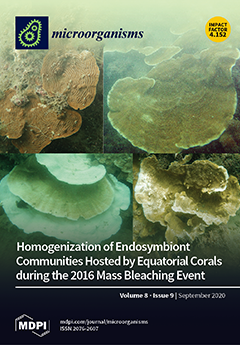Bacteriophages are viruses capable of recognizing with high specificity, propagating inside of, and destroying their bacterial hosts. The phage lytic life cycle makes phages attractive as tools to selectively kill pathogenic bacteria with minimal impact on the surrounding microbiome. To effectively harness the
[...] Read more.
Bacteriophages are viruses capable of recognizing with high specificity, propagating inside of, and destroying their bacterial hosts. The phage lytic life cycle makes phages attractive as tools to selectively kill pathogenic bacteria with minimal impact on the surrounding microbiome. To effectively harness the potential of phages in therapy, it is critical to understand the phage–host dynamics and how these interactions can change in complex populations. Our model examined the interactions between the plant pathogen
Erwinia amylovora, the antagonistic epiphyte
Pantoea agglomerans, and the bacteriophages that infect and kill both species.
P. agglomerans strains are used as a phage carrier; their role is to deliver and propagate the bacteriophages on the plant surface prior to the arrival of the pathogen. Using liquid cultures, the populations of the pathogen, carrier, and phages were tracked over time with quantitative real-time PCR. The jumbo
Myoviridae phage ϕEa35-70 synergized with both the
Myoviridae ϕEa21-4 and
Podoviridae ϕEa46-1-A1 and was most effective in combination at reducing
E. amylovora growth over 24 h. Phage ϕEa35-70, however, also reduced the growth of
P. agglomerans. Phage cocktails of ϕEa21-4, ϕEa46-1-A1, and ϕEa35-70 at multiplicities of infections (MOIs) of 10, 1, and 0.01, respectively, no longer inhibited growth of
P. agglomerans. When this cocktail was grown with
P. agglomerans for 8 h prior to pathogen introduction, pathogen growth was reduced by over four log units over 24 h. These findings present a novel approach to study complex phage–host dynamics that can be exploited to create more effective phage-based therapies.
Full article






